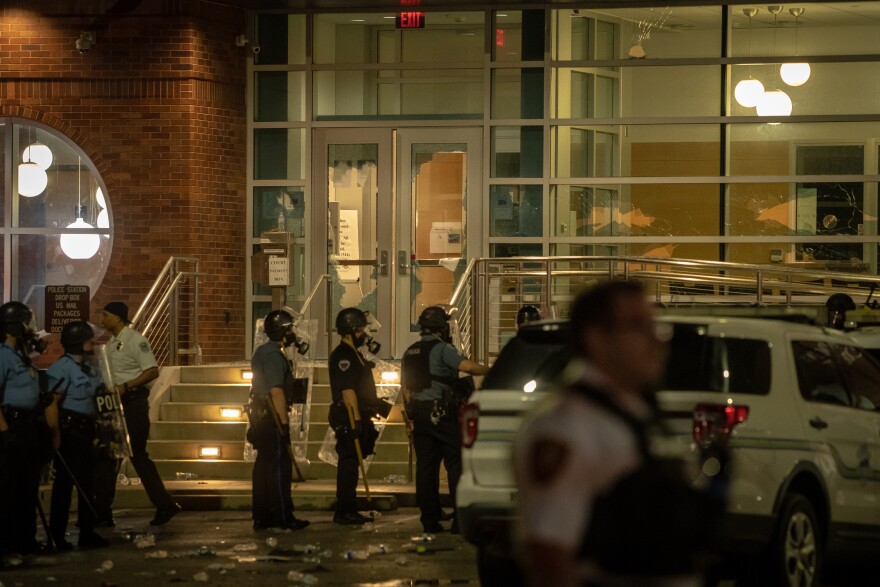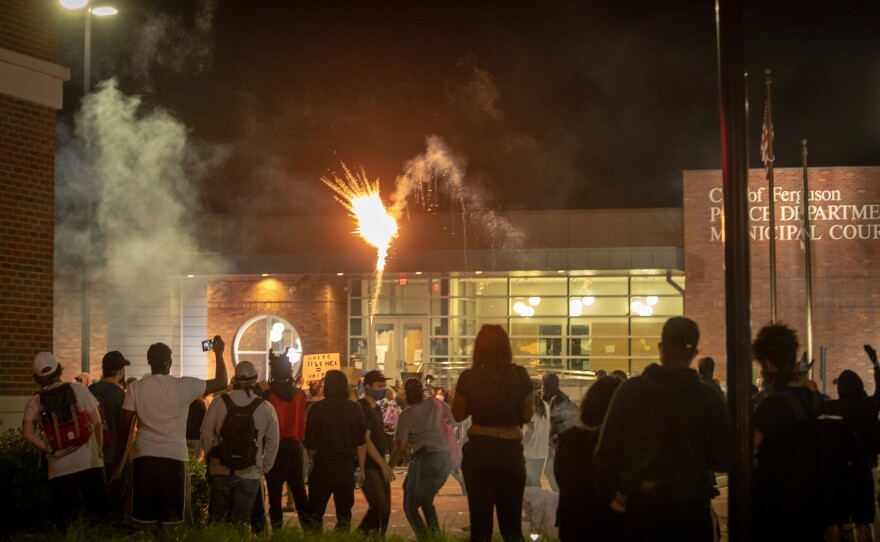Updated 7 a.m. May 31 with police information.
Protesters brought havoc and destruction to Ferguson’s police headquarters and the city’s downtown at the end of a night of protests against police brutality mirrored around the nation Saturday.
The demonstrations and their ensuing vandalism were sparked by the death last week of George Floyd, a black man who died after a Minneapolis police officer restrained him by kneeling on his neck. Protests began in that city and have since spread across the country.

The demonstrators’ anger, chants, language and destruction are akin to the Black Lives Matter movement’s protests in the same community nearly six years ago when a white Ferguson police officer killed Michael Brown, an unarmed black teenager. Eric Garner and Tamir Rice were also killed that year in New York City and Cleveland. Weeks of protests, destruction and heavy police response followed Brown’s death.
Saturday night in Ferguson, the scene was repeated. Several hundred protesters blocked South Florissant Road and occupied the police station parking lot.
“My father, when I was a teenager, he used to tell me how to conduct myself, things that happened to him when he was a child dealing with police matters,” said Ronnie Lotts, 54, from St. Louis. “It’s a shame I have a 19-year -old son and I’m having to have the same conversations with him.”
Lauren Davis came to the protest from Belleville. She said she’s sick of people telling African Americans how they’re supposed to feel.
“How many more?” Davis asked. “Just give me a number and I’ll be happy. I want to know when we’re allowed to be upset about people losing their lives constantly.”
The protest, which began about 6 p.m., was mostly peaceful — at one point before nightfall, several officers joined protesters in taking a knee — until about 10 p.m.
Eventually, protesters used baseball bats to smash the police station glass doors and lobbed volleys of fireworks toward police in the parking lot and into the police station. Police eventually fired pepper spray and smoke grenades toward protesters.

The standoff continued for several hours as protesters threw rocks, broke windows and spray-painted anti-police graffiti. Fires were set in the street and inside at least one store, according to a Post-Dispatch reporter who witnessed it. Looters carried armfuls of merchandise out of the Beauty World store on South Florissant Road.
The city of Ferguson issued a midnight curfew, according to Five On Your Side, though crowds thinned but did not disappear. St. Louis County Police later reported shots being fired but did not announce any injuries from the gunfire. The department said that crowds dispersed shortly before 2 a.m.
County police reported seven officers were injured from the rocks, bottles and fireworks, three officers were taken to the hosptial. Police also confirmed evidence of vandalism and evidence that several businesses had been broken into. No arrests have been made.
Gov. Mike Parson declared a state of emergency Saturday night, citing unspecified "civil unrest" throughout the state. In a statement, he said the declaration includes activating the Missouri National Guard and having the Highway Patrol ready to help local authorities.
"We are deeply saddened by the tragic death of George Floyd," Parson said. We are also saddened by the acts of violence that have transpired across our nation and state in response to this event. At this time we are taking a proactive approach to protect Missouri and its people."
The protest in Ferguson and marches in Clayton and University City earlier in the day were part of a string of protests nationwide that sprang up this week after a video of a police officer kneeling for several minutes on the neck of Floyd shocked the nation. Floyd could be heard saying he couldn’t breathe and soon died. The officer was fired last week and charged with murder and manslaughter Friday.
Hundreds of people also marched in downtown St. Louis to protest Floyd’s death Friday night. Demonstrators blocked traffic on Interstate 70.
Original story from Saturday afternoon:

Demonstrations shifted Saturday to St. Louis County. People gathered by the hundreds in Clayton and blocked traffic as they marched down Forest Park Parkway to University City.
The afternoon march began at the St. Louis County Justice Center in Clayton. It featured a condemnation of violence against African Americans over the past few weeks, most notably Floyd’s death.
“We are here because of what happened in Minneapolis, but there have been many killings around this country by police officers,” said the Rev. Daryl Gray. “Not just in recent days, weeks and months. But throughout the years.”
The multiracial crowd marched through the streets of Clayton, and then streamed onto Forest Park Parkway. They chanted, banged drums and held up signs decrying the deaths of black people killed by police. Demonstrators eventually made it to University City, where they marched through the Loop business district. The crowd dispersed close to Washington University.
Gray noted that the St. Louis area “became the epicenter for civil rights because of Mike Brown,” a reference to the protest movement that emerged in 2014 after a Ferguson police officer killed the 18-year-old.
A number of speakers at Saturday afternoon’s rally took part in the protest movement in Ferguson, including state Rep. Rasheen Aldridge, D-St. Louis.
“How many more bodies do we got to see?” Aldridge said. “We are tired. It’s a simple message. It’s not hard to understand. We are tired of people of our color being killed in our streets by police brutality. No justice is ever served.”

The Clayton protests came a day after hundreds of people marched in downtown St. Louis to protest Floyd’s death. Demonstrators blocked traffic on Interstate 70. Sgt. Keith Barrett of the St. Louis Metropolitan Police Department said a man was killed after he climbed onto a truck and was run over by a trailer tire. Barrett added that police didn’t make any arrests.
County officials reflect on Floyd’s death
The impending protests were on the minds of several of St. Louis County’s elected officials, including County Executive Sam Page.
In a press conference Friday, Page said that when “our police officers don’t meet our standards, we expect them to be held accountable — that’s the message we’ve always had for the community.”
“If people want to protest peacefully, I’m sure that we will support that — and we will provide them with the support that they need,” Page said. “But if that turns into something that’s less constructive, then we’ll react appropriately. I’ll leave that to our county municipal police departments. We are certainly monitoring the situation and we will continue to do so.”
Page called the video of Floyd “horrifying” and went on to say that “we hope that we can learn from what is clearly a tragic event and that we can move forward as a community and a country.”
During an appearance Friday on the Politically Speaking podcast, Councilwoman Kelli Dunaway said she expected a different approach from the St. Louis County Police Department from how it handled the Ferguson protests in 2014. She pointed to the department having a new chief, Mary Barton, and a different police board.
“I want to see our law enforcement standing with our protesters,” said Dunaway, D-Chesterfield. “This is not who we are. This is not who we’re going to be. We learned. And we’re still learning. And we’re going to continue to get better new leadership.”
St. Louis Public Radio's Lindsay Toler contributed reporting.
Send questions and comments about this story to feedback@stlpublicradio.org










